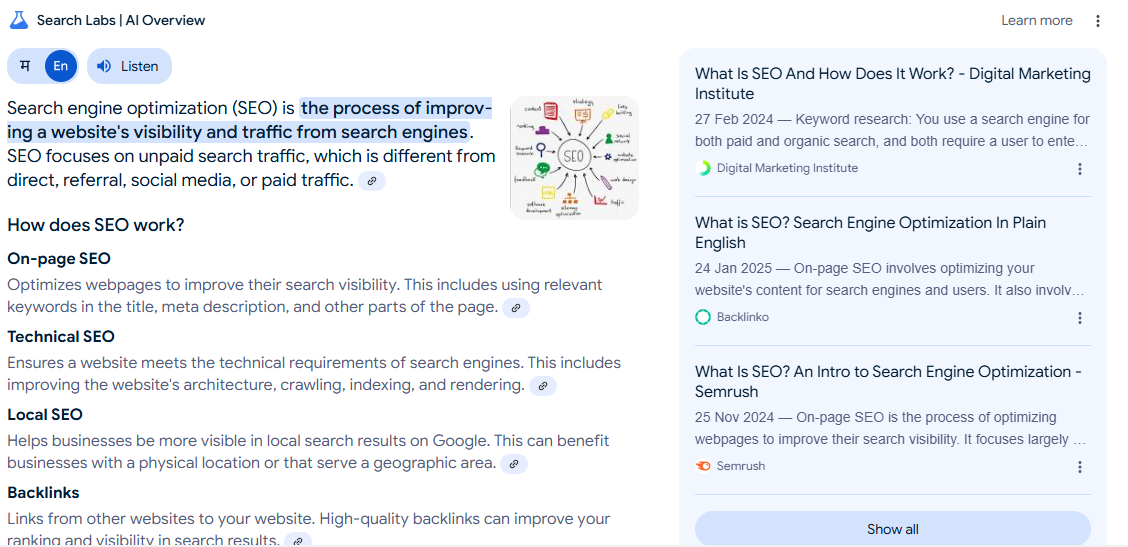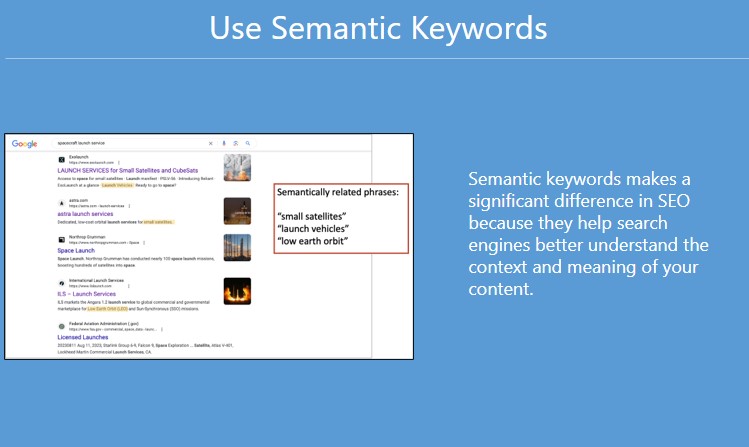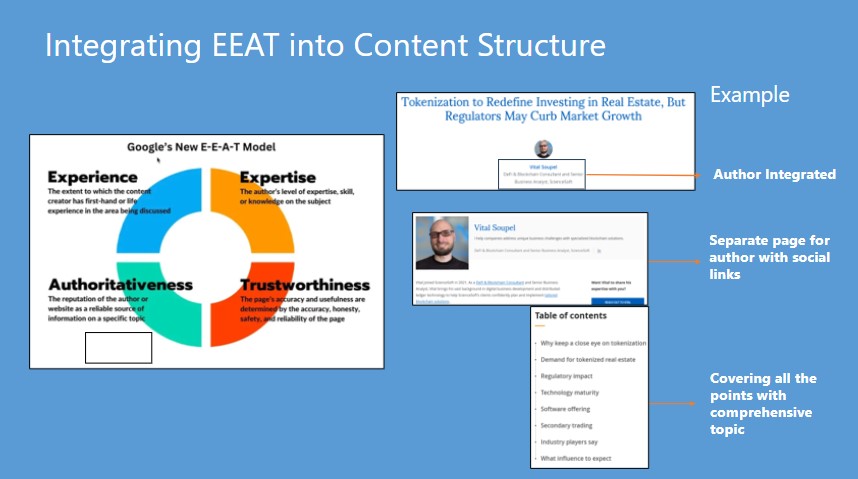You’ve spent hours crafting the perfect blog post, packed it with keywords, optimized every heading, and hit publish—only to see your content buried under AI-generated summaries. Welcome to the world of AI Overviews, where traditional SEO isn’t enough anymore.
Gone are the days when stuffing your article with keywords and backlinks could guarantee a top spot on Google. Today, AI-driven search engines are doing more than just ranking pages—they’re curating and summarizing the best answers directly on the results page. If your content isn’t optimized for AI Overviews, you risk getting left behind while AI cherry-picks someone else’s work.
So, how do you ensure that your content is the one AI Overviews showcase? How do you make Google’s AI work for you rather than against you? Let’s figure out.
What are AI Overviews?

AI Overview/Ajtechdigital
AI Overviews, previously known as Search Generative Experience (SGE), represent Google’s approach to offering AI-powered summaries. These summaries reduce the need for users to click through individual links, presenting an instant, AI-generated answer.
Why ranking in AI Overviews is important?
- Increased Visibility: AI Overviews highlight content directly on the search page.
- Position Zero Evolution: Building on featured snippets, AI Overviews take top-ranking content to a new level.
- Changing User Behavior: Users increasingly trust AI-generated responses, making AEO a necessary adaptation for content creators.
What are Large Language Models (LLMs) and what is their role in AI Overviews?

LLM/Unsplash
Large Language Models (LLMs) power AI Overviews by processing vast amounts of text data and generating human-like responses. These models, such as GPT-4, Google’s Gemini, and BERT, analyze and synthesize content to provide relevant and concise summaries for search queries.
How LLMs influence AI Overviews?
- Natural Language Processing (NLP): LLMs understand and interpret search intent beyond simple keyword matching.
- Contextual Awareness: These models assess the surrounding context to improve accuracy in responses.
- Data-Driven Learning: LLMs continuously refine their understanding by analyzing vast datasets, making AI-generated answers more precise.
- Content Selection: AI Overviews prioritize authoritative, structured, and factual content, which LLMs determine by evaluating credibility and relevance.
How to optimize content for LLM-Driven AI Overviews?
- Use Clear and Direct Language: LLMs favor concise and structured content over complex or verbose writing.
- Incorporate Semantic SEO: Focus on related keywords, synonyms, and topic clusters to align with LLM processing.
- Ensure High-Quality Sources: Citing authoritative sources strengthens content credibility, making it more likely to be included in AI Overviews.
- Enhance Readability: Well-organized, easy-to-read content with bullet points and structured formatting improves visibility.
How to Rank in AI Overviews?

AI overviews/ Unsplash
1.Write Concise Yet Comprehensive Content
AI Overviews prioritize structured, authoritative, and clear responses. To optimize content:
- Provide Direct Answers: AI selects content that addresses search intent directly.
- Use the Inverted Pyramid: Place key information at the beginning.
- Eliminate Redundancies: AI models prefer succinct, information-rich text.
- Use Bullet Points and Lists: AI Overviews favor structured formats that improve readability.
- Include Data and Statistics: Credible numerical insights increase the chances of AI recognition.
Example:
Instead of:
“If you’re looking to improve your rankings in AI Overviews, one of the best ways is to focus on writing structured content that is easy for AI models to process.”
Use:
“To rank in AI Overviews, write structured, fact-based, and concise content.”
2. Leverage Question-Based Content
AI Overviews focus on answering questions. Structure content using:
- Commonly Asked Questions: Address search queries using question-based headers.
- People Also Ask (PAA) Insights: Utilize Google’s PAA box to identify trending queries.
- Conversational but Authoritative Tone: Ensure readability without losing credibility.
- Create FAQ Sections: A structured FAQ at the end of an article enhances visibility in AI Overviews.
Tip: Use headings and bullet points to improve AI comprehension.
3. Optimise for Semantic Search and NLP

semantic keywords/ajdigitaltech
Search engines analyze meaning rather than just keywords. Optimize content by:
- Focusing on Entities: Mention specific terms, brands, locations, and dates.
- Using Variations and Synonyms: Avoid repetition; use alternatives for better indexing.
- Maintaining Natural Language Flow: Prioritize readability over keyword stuffing.
- Optimize for Voice Search: Overviews often cater to voice-based queries, so keep answers conversational and direct.
4. Enhance E-E-A-T (Experience, Expertise, Authoritativeness, Trustworthiness)

EEAT/ajtechdigital
Google evaluates credibility based on:
- Expertise: Content authored by industry professionals.
- Authoritative References: Citing research, case studies, and credible sources.
- Trust Signals: Including author bios, external validation, and transparent policies.
- User Reviews and Testimonials: AI considers social proof when ranking content.
- Regularly Update Content: Outdated information can hurt credibility in AI Overviews.
5. Implement Structured Data and Schema Markup
AI relies on structured data for content parsing. Use:
- FAQ Schema: Increases chances of AI selection.
- How-To Schema: Ideal for step-by-step guides.
- Entity Schema: Strengthens topic connections.
- Article Schema: Helps define article type and structure.
- Speakable Schema: Optimizes content for AI-generated voice search results.
6. Acquire Authoritative Backlinks
Backlinks enhance AI credibility. Strategies include:
- Guest Blogging: Publish articles on niche-relevant sites.
- Digital PR Campaigns: Obtain mentions in authoritative publications.
- Strategic Internal Linking: Connect related pages for AI comprehension.
- Collaborate with Influencers: High-authority mentions increase credibility.
7. Improve Page Experience and Core Web Vitals
AI favors high-performance websites. Optimizations include:
- Fast Load Times: Implement CDNs, image compression, and caching.
- Mobile-Friendly Design: Prioritize mobile responsiveness.
- User Engagement Metrics: Improve dwell time, session duration, and bounce rate.
- Reduce Intrusive Ads: Overviews prioritize user-friendly experiences.
- Enhance Readability: Use simple language, short paragraphs, and clear fonts.
8. Optimize for Local SEO and AI Maps Integration
Local businesses can leverage AI Overviews by optimizing for local search.
- Claim Google My Business Listing: Overviews pull data from GMB.
- Use Location-Based Keywords: Mention cities, regions, and landmarks.
- Get More Reviews: AI trusts businesses with high-rated, frequently-reviewed listings.
- Include NAP Information: Ensure Name, Address, and Phone Number are consistent across platforms.
What is Google’s take on AI Overviews?
According to CNBC, Google’s CEO Sundar Pichai recently was quoted saying “Google will introduce a number of AI features in the first half of the year.” He also warned it would be a challenging year, as “we are facing scrutiny across the world.”
Conclusion
Ranking in AI Overviews is about delivering precise, valuable content in an AI-friendly format. Have AI Overviews impacted your rankings? Share your insights below.
